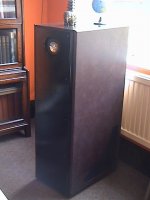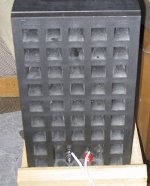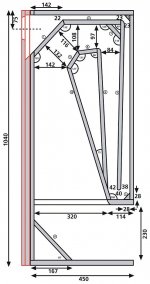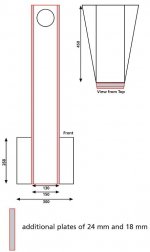Diffusion? A question of scale...
In studios, guys used to stack river rock and mortar on the walls to break up standing waves without loosing energy. These days RPG flutter free seems more popular. I have a few 4x6” scraps if your interested. Perhaps a glue gun and a bunch of pebbles?
In studios, guys used to stack river rock and mortar on the walls to break up standing waves without loosing energy. These days RPG flutter free seems more popular. I have a few 4x6” scraps if your interested. Perhaps a glue gun and a bunch of pebbles?
Re: Diffusion? A question of scale...
very interesting products...unfortunately they look like they would reduce box volume...unlike the hp diffusors...but pebbles, or any random reflective surface without much depth...
chances are i will end up using a combo of reflective and absorptive, methinks...
ima hafta get all empirical on this boxes' asterisk. what else is new? 🙂
Da5id4Vz said:In studios, guys used to stack river rock and mortar on the walls to break up standing waves without loosing energy. These days RPG flutter free seems more popular. I have a few 4x6” scraps if your interested. Perhaps a glue gun and a bunch of pebbles?
very interesting products...unfortunately they look like they would reduce box volume...unlike the hp diffusors...but pebbles, or any random reflective surface without much depth...
chances are i will end up using a combo of reflective and absorptive, methinks...
ima hafta get all empirical on this boxes' asterisk. what else is new? 🙂
I built a pair of horns a few months ago and smeared thick bathroom type sealant (silicone rubber) on one wall or the cabinet throughout the horn, and ran a course comb over it randomly, before I sandwiched it shut with the other side panel really smoothed out the lumpy and very audible peaks and troughs greatly. Don't know how much it costs as I had a plentiful supply from work, but it can't be much. It took a tube per cabinet.
Must be cheaper than 50 bucks, and you could make them movable by smearing it onto bits of card or thin plastic and stapling or screwing them in.
Once its set, you can cut them with scissors or a sharp knife.
Must be cheaper than 50 bucks, and you could make them movable by smearing it onto bits of card or thin plastic and stapling or screwing them in.
Once its set, you can cut them with scissors or a sharp knife.
Attachments
Others have also reported good results using silicone as a diffuser/absorber. There's also Deflex, which AFAIK, is basically a manufactured version with a fresnel reflector molded into the silicone.
I understand that in Japan, the vertical spacer/dividers in the last bend of the newer fostex backhorn designs are often filled with river pebbles. Sounds like a good idea.
GB
I understand that in Japan, the vertical spacer/dividers in the last bend of the newer fostex backhorn designs are often filled with river pebbles. Sounds like a good idea.
GB
noisenyc said:b&w has been doing an "egg crate" style bracing
Each one of the squares is an approx 4" tall pyramid on the inside of the box.
dave
Attachments
I have some backloaded horns with the mouth facing forward, below the driver. I had some honkiness on some passages. I am currently listening to them with an aperiodic vent off of the side of the compression chamber to bleed off some pressure and thin felt behind the driver. It took care of the honk but I find the volume knob gets turned more, not really a bad thing, I guess. Not sure I'll keep the mod though. Wifey thinks they rock

Da5id4Vz said:Is that the B&W?
Looks intersting.
Whats it made of?
DM302... plastic
dave
So if you plaster one parallel wall with marbles or pebbles or shards of glass and a "reflective" adhesive, does it matter what diameter of particles you use? I know we must account for taking up internal volume, but what about the wavelengths diffused compared to the diameters and/or curvatures of the points doing the deflecting?
Sincerely,
Brad
Sincerely,
Brad
brad212 said:does it matter what diameter of particles you use?
In this case, size does matter... larger objects/differences in wall distance have affects at lower freqencies.
dave
Hey Dave,
Thanks for the reply.
I'm a newbie to horns (but it's in my blood as I'm from Arkansas - Klipsch Country).
I have built closed boxes, vents, TLs and electrostatics - this new horn learning fascinates me. I am not familiar with doing anything with the "standing waves" except quashing them. I love the idea of harnessing their acoustical energy instead - it's efficient, duh.
Figuring the wave length of the "standing waves" is easy enough from the box geometry.
So are you saying that it would be a waste of time to apply any material internally that was not of a compatible geometry to diffuse the wave lengths in question?
Do you know of an easy way to calculate the proper angular geometry for these matching diffusers?
Sincerely,
Brad
Thanks for the reply.
I'm a newbie to horns (but it's in my blood as I'm from Arkansas - Klipsch Country).
I have built closed boxes, vents, TLs and electrostatics - this new horn learning fascinates me. I am not familiar with doing anything with the "standing waves" except quashing them. I love the idea of harnessing their acoustical energy instead - it's efficient, duh.
Figuring the wave length of the "standing waves" is easy enough from the box geometry.
So are you saying that it would be a waste of time to apply any material internally that was not of a compatible geometry to diffuse the wave lengths in question?
Do you know of an easy way to calculate the proper angular geometry for these matching diffusers?
Sincerely,
Brad
brad212 said:I'm a newbie to horns (but it's in my blood as I'm from Arkansas - Klipsch Country).
You'll want to read Dinsdale (the pdfs i scanned are hosted out on the net somewhere), Marshall Leach (on his website), and Martin Kings series of papers.
Althou none of these is definitive, they all add together to give a good handle on horn design.
So are you saying that it would be a waste of time to apply any material internally that was not of a compatible geometry to diffuse the wave lengths in question?
All the math for horns is derived from circular xSections, so serious deviation from that takes you into cut & try-land. The back chamber thou -- because it is often small, typically benefits from anti-resonant-wave, internal reflection treatment.
dave
jsaults said:I have some backloaded horns with the mouth facing forward, below the driver. I had some honkiness on some passages. :
Would it be better making a fullrange backloaded horn with
the mouth facing backwards... just an idea nothing more
weidok said:Would it be better making a fullrange backloaded horn with
the mouth facing backwards... just an idea nothing more
That is my preference.
dave
weidok said:
Would it be better making a fullrange backloaded horn with
the mouth facing backwards... just an idea nothing more
planet10 said:
That is my preference.
dave
Is there a good example .. i am planning use
Fostex FE 167 E in a TQWT or Backloaded horn
(with the mouth on the back) ....
weidok said:Is there a good example ..
Buschorn II, CheapTrick, Ed's The Horns, Carfae (althou the pictured one is more accurately described as side mouths)
An externally hosted image should be here but it was not working when we last tested it.
dave
weidok said:How about the CT 164
Just for reference, the CT stands for Cheap Trick... it was one of the inspirations for the horn i am working on right now.
dave
- Status
- Not open for further replies.
- Home
- Loudspeakers
- Full Range
- word to all you backhorn tweakers.



